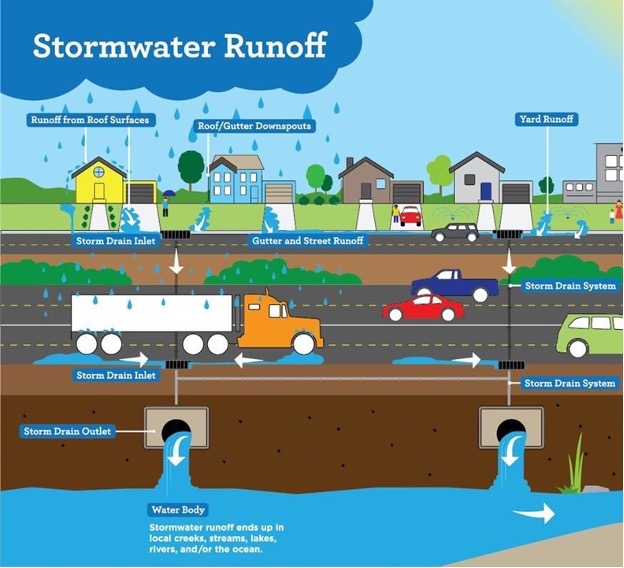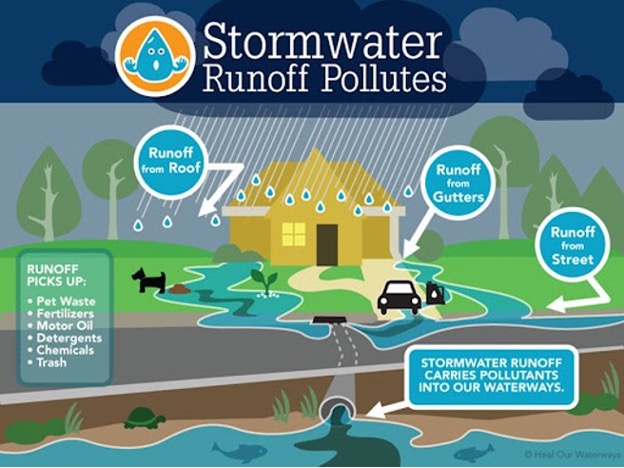MS4 Permit Program – IEPA ILR40 Permit
The MS4 program originated based upon the ILR40 permit issued by the Illinois Environmental Protection Agency (IEPA). MS4 stands for “municipal separate storm sewer system”, where the word municipal refers to a local unit of government, such as a township, city, or village. It is defined as “separate” because it is not connected to the sanitary sewer system, instead it collects water from impermeable surfaces such as the road, rooftops, etc. and transports it via the storm sewer system to a stream, detention pond, or other water body via a system of pipes. This permit is renewed every 5 years. Upon renewal, each MS4 must update its stormwater management program plan (SMPP). The SMPP is a statement and descriptor of how the requirements within the permit will be met by the MS4 (Fremont Township’s SMPP: https://www.gha-engineers.com/wp-content/uploads/2017/07/Fremont-Twp-SMPP-2016-No-appendices.pdf).
Purpose
The intent of the federally mandated permit is to protect our stormwater from pollution and address any pollution issues that may occur. To do so, there are 6 minimum control measures outlined in the MS4 permit including;
- Public Education and Outreach on Storm Water Impacts
- Public Involvement/Participation
- Illicit Discharge Detection and Elimination
- Construction Site Storm Water Runoff Control
- Post-Construction Stormwater Management
- Pollution Prevention and Good Housekeeping Municipal Operations
How and why do we participate?
Stormwater runoff travels over a variety of surfaces including rooftops, driveways, roadways, parks, etc. These surfaces are often covered with various pollutants such as animal feces, trash, chemicals, fertilizers, etc. The water that travels over these polluted surfaces often picks up much of this pollution and carries it through the MS4. To prevent these pollutants from causing our infrastructure damage, impeding our health and compromising our environment it is imperative we monitor and actively fight these pollutants. How does the Township monitor and address stormwater pollution?
- The outfalls, streambanks and basins maintained by the Township are inspected yearly for signs of pollution, damage, and erosion.
- An annual report is completed every year which includes a summary of the inspections and their results and efforts by the Township and Lake County to educate and actively reduce pollutants in the area.
- The Township is a member of the Des Plaines River Watershed Workgroup and participates in the Fox River Study Group. Both entities conduct water quality testing and monitoring throughout their respective watersheds.
- Street sweeping, no dumping signs on storm drains, and culvert cleaning are a few ways the Township is actively addressing pollution.
The Township is constantly working to improve storm water quality. If there is anything you notice should be addressed, please let us know. (insert GHA contact site, or the Township’s if you have one)
To further combat pollution within our community, the Township works with Gewalt Hamilton Associates to complete the inspections and our Annual Report. All annual reports, SMPP and other documentation can be found at their website: https://www.gha-engineers.com/ms4/

What exactly are pollutants?

Common pollutants found in storm water include;
Fecal Matter
While wildlife is a welcomed neighbor within our community, their feces can be quite harmful to our storm water. Animal feces often carries pathogens and nutrients, which in excess cause algae in water and weeds on land. Dog feces are also a concern for similar reasons in addition to the common diseases it carries which is transmissible to other domestic pets (giardia, hookworms and parvovirus).
What you can do:
Pick up your dog’s poop!
Oils and Soaps:
The most easily identifiable pollutant in stormwater systems within our area is oil and/or soap. Oil from oil changes on cars, routine maintenance on motorized vehicles and general home improvements often finds its way into a storm drain. If enough oil is leeched into the storm water, it creates an oil sheen on top of the water projecting shades of purple and orange. Similarly, the detergent used in washing machines can find its way into the storm water system via a drainpipe from a washing machine that outlets to the nearest creek or waterway. In each case, these pollutants can become difficult to address depending on the amount of pollutant that has entered the waterway and how far it has traveled from its source.
What you can do:
Make sure you do not have a pipe directly draining from your washing machine into a nearby water body. Change your car’s oil within an enclosed area where you can ensure all oil will be collected and properly disposed of.
Litter and Debris:
Leaves, grass clippings, sticks and large branches all tend to congregate around storm drains. As water flows, especially in large storm events, it tends to carry debris with it. This debris can clog the storm drain and prevent water from draining the area correctly. While this isn’t necessarily considered “pollution” directly, it can cause structural and functional issues. In excess, when leaves and other smaller debris enters the storm drain system and begins to degrade it can decrease the oxygen levels and negatively affect wildlife within the nearest waterbody.
What you can do:
Rake your leaves and place them in a yard waste bag with any sticks or large branches as well as grass clippings. If you pile your leaves at the curb, wait until the last minute to rake. Mulching your leaves when you cut your grass provides good nutrients for the soil and reduces yard waste within the storm drain system. When you have exposed dirt in your yard cover it with erosion control blanket and seed. If there is a storm drain near your home that you see clogged, try to remove as much debris as possible.
Nutrients and toxic compounds
This category includes any form of lawn care such as fertilizer, pesticide or herbicide in addition to vehicle fluids, paints, stains and metals and cleaning products. These items when introduced to storm water, cause an imbalance in nutrient levels. Each of the listed items contains various chemicals and nutrients which can harm aquatic and plant life. Phosphorous and nitrogen are the major culprits.
What you can do:
When using any yard improvement products such as fertilizer, herbicide, or pesticide, be sure to follow the instructions on the container and do not overspray! The same can be said for household cleaners. When painting, keep paint contained and clean all supplies in a sink or other contained area.

